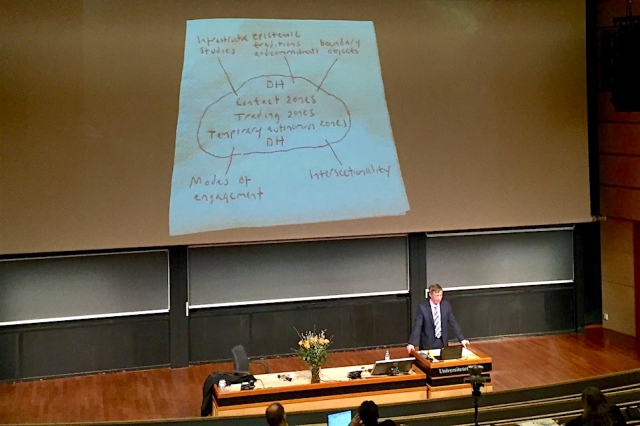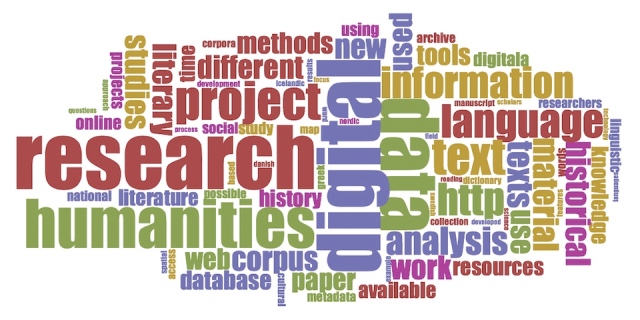This is the second of two posts on the ”Digital Humanities in the Nordic countries” conference held in Oslo on 15–17 March, 2016. The previous post can be found here.
Day 2 of DHN 2016 opened with a plenary lecture by Patrik Svensson, former director of the leading Nordic centre for what is now called digital humanities, HUMlab in Umeå. He began his keynote, entitled ”Can there be a Nordic digital humanities?” (abstract | references), by characterizing the state of DH as either ”unsettled” or ”dynamic” depending on your point of view. However, he also argued that it is a sign of progress that much of the program at DHN was content-driven, discussing actual projects and the issues they raise rather than using sample data only as a means of illustrating methodological questions.
Svensson then went on to situate the new association for Digital Humanities in the Nordic countries in its international institutional context of EADH, ADHO etc, in part by performing a sort of close reading of the stated goals and principles of each in official documents. This served to highlight some of the well-known tensions within the ”field”, if indeed it is a field, of DH and the questions about how to define it. In that context I thought it was a rather telling sign that only a handful of the whole audience of perhaps 150 people raised their hands when Svensson asked how many were readers of one of the leading DH journals, the Digital Scholarship in the Humanities.
My distinct impression from both the presentations and talking to attendees is that many of the conference participants can be described as friends, allies or stakeholders in DH rather than ”digital humanists” in any strong sense of the word. But is that necessarily a bad thing? I don’t think so, since it provides a lot of the diverse and ”dynamic” (to use Svenssons’s term) character of Nordic DH at the moment. (Although I can see how it might be frustrating to some of the more involved and self-identified digital humanists, who have a more narrow definition of what DH means and where it should be heading.) In that sense, I personally really liked Svensson’s suggestion toward the end of his lecture that digital humanities is ”a contact zone rather than a discipline”, and that another way of understanding it is as a ”humanities infrastructure platform”.

Patrik Svensson delivering his keynote address on 16 March at DHN 2016 in Oslo.
Unfortunately I could not attend any session in the time slot after the keynote, when I had planned to listen to five papers on ”Map vizualisations”. However, there was a lively stream of tweets coming out of the room during the proceedings, which included a number of links to the projects being presented and other related websites. Since it might be of interest I have listed a selection of those in the ”Additional links” at the end of this post.
For the fourth and last paper session of DHN 2016 I chose one on ”Digital history”, where four projects in various stages of completion were presented. First Anna Nilsson Hammar (Lund) talked about ”Starting small”, referring to a collaboration between historians and librarians in developing a guide to the special collections of the Lund University Library. She emphasized the need to sometimes begin this kind of work on a small scale and then let it grow gradually, but also stressed the importance of ”formalising collaboration and knowledge exchange”. A more general point of hers that I think is very true is that in order to increase the accessibility and usability for research of collections it can be very valuable or even necessary to engage not only librarians but also historians (and/or other researchers).
Next was Gísli Pálsson’s work-in-progress on ”abandonment, reoccupation and land use in early 18th century Iceland”, which provided some really interesting discussions about networks of ownership and control of resources among early modern Icelandic farms. To show his results and discuss some of the details Pálsson used map visualizations of land use as well as the networks of influence between the studied farms. After him came a group of researchers from my own university, Gothenburg, who have just begun working on an online biographical dictionary of Swedish women. The project is done in cooperation with Språkbanken and SWE-CLARIN, and the discussion came to focus mainly on criteria for selecting the individuals to be included, demarcation issues etc.
The final paper of the day was given by Sverker Lundin and Trausti Dagsson, also from the University of Gothenburg, and the title of their talk was ”Mapping life-stories of the Moravian Church, 1730–2000”. They are working to digitize, analyse and make accessible more than 20,000 Lebensläufe, a specific genre of spiritual ”life stories” produced within the Moravian Church. These narratives are being collected in a database, which can be queried through a web based interface that will allow various types of searches and cross-referencing of metadata. (Incidentally, on a generic level that sentence might also serve to describe the basic model of quite a few of the projects demoed in the course of the conference.) An early version of the database can currently be found at http://lebenslauf.sagnagrunnur.com, and it will shortly move to a more permanent home at http://moravianlives.org.

Word cloud of the DHN 2016 abstracts by Annika Rockenberger (source)
In the morning of the third and last day of DHN 2016, Nicole Saylor from the Library of Congress delivered a plenary lecture on ”Documenting folklife in the digital age”. I was not there but it seems to have been an interesting talk where Saylor, among other things, stressed the irrevocable shift of our everyday cultural record and all of the data it generates to digital forms. In the poster session at the National Library of Norway that followed afterwards there were many interesting cases and projects being demonstrated that also broadened the scope from the general model of website-on-top-of-database mentioned above – although here, too, quite a few of the examples fit that description. However, at least for now it is beyond my ability to distill any more general conclusions from the diversity of this session in a paragraph or two.
The same might be said for the concluding panel discussion after lunch, but there are a few themes and points that from my perspective seem especially pertinent. The session was led by Anders Fagerjord and the four panelists were Anne Baillot, Mikko Tolonen, Bente Maegaard and Hege Stensrud Høsøien. First, they gave one lightning talk each with a response to the organizers’ question on whether the digital humanities represent a paradigm shift for the humanities as a whole, and then the floor was opened up for a more general discussion. All of the panelists stressed the many changes and challenges brought on by the digital transformation of academia and society, but if it is (or will be) a paradigm shift depends largely on how that term can (or should be) defined. In this context Anne Baillot mentioned the ”lack of recognition” for non-traditional academic work that still prevails, and Mikko Tolonen reinforced the point that movement has been too slow because there is still much resistance among scholars to adopt DH perspectives and practices.
That assessment, however, raises yet again the issue from earlier of what we actually mean with ”digital humanities”, and who should count as a ”digital humanist”. More importantly, it leads us quite naturally on to one of the last questions asked during the panel discussion and (to my mind) the most interesting of all: ”Will there be a ‘digital humanities’ in 20 years, or just ‘humanities’?” On this, all of the panel seemed to agree that ”DH” is a transitory label that will eventually fade away, since in the long run the ”digital” will inevitably become fully integrated into (all of) ”the humanities”.
I hope and believe that they are right in this prediction, not because I’m a ”digital humanist” (I’m not) but because I’m a humanist, and historian, in an age where so much of human life and interaction – both in the present and with the past – is digitally mediated that if you exclude it there is barely anything left of the humanities. So the question is not, and for a long time has not been, if we should incorporate the digital into the humanities but how. I think we’ve seen many promising examples of what answers to that question might look like in Oslo over the last three days.
Additional links
• Digisam guidelines ”for digitisation, preservation and digital access to cultural heritage”
• The Digital Atlas of the Roman Empire
• The Early Monasticism and Classical Paideia project
• Historical European newspapers
• Pelagios Commons (cross-linking place names and historical documents)
• Sagnagrunnur (a database of published Icelandic legends)